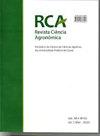青椒灌溉生产中的缺水管理
IF 0.7
4区 农林科学
Q3 AGRICULTURE, MULTIDISCIPLINARY
引用次数: 0
摘要
-在种植青椒时,灌溉管理方面的信息对于取得令人满意的结果至关重要。因此,本研究的目的是评估水分不足对青椒生产、生长和生理的影响,水分不足随物候阶段的变化而变化。实验设计是完全随机的,有7个处理,4个重复,地块包括2个植物。处理包括在物候期I、II、III和IV(按百分比等计算)更换需水量:T1 - 100%/I、100%/II、100%/III和100%/IV;T2 - 100%/I, 75%/ II, 100%/III和75%/IV;T3 - 100%/I, 75%/II, 75%/III和75%/IV;T4 - 100%/I, 75%/II, 75%/III和50%/IV;T5 - 100%/I, 50%/ II, 75%/III和50%/IV;T6 - 100%/I, 50%/II, 50%/III和50%/IV;T7 - 100%/I, 50%/II, 50%/III和25%/IV。这些植物是在滴灌的情况下在田里种植的。分析了以下变量:株高;茎粗、叶面积、茎干重、单株果数、可溶性固形物、果长、果粗、果重、生产力、相对叶绿素指数、气体交换和水分利用效率。与T1相比,基于T2、T3和T4的处理并没有降低绝大多数植物性变量的表达或气体交换。T2的耗水量可以在不显著降低生产效率的情况下使用,与T1相比,总用水量节约12.5%。T1和T2给出了水利用效率的最高值。因此,在大田条件下栽培青椒,推荐采用T1和T2管理。本文章由计算机程序翻译,如有差异,请以英文原文为准。
Management of water defi cit in the irrigated production of the green pepper
- Information on irrigation management is essential for achieving satisfactory results when cultivating the green pepper. The aim of this study, therefore, was to evaluate the e ff ects of water de fi cit, which varies according to phenological stage, on the production, growth and physiology of a crop of green peppers. The experimental design was completely randomised, with seven treatments, four repetitions, and plots comprising two plants. The treatments consisted of replacing the water demand during phenological phases I, II, III and IV (in terms of percentage ETc): T1 – 100%/I, 100%/II, 100%/III and 100%/IV; T2 – 100%/I, 75%/ II, 100%/III and 75%/IV; T3 – 100%/I, 75%/II, 75%/III and 75%/IV; T4 – 100%/I, 75%/II, 75%/III and 50%/IV; T5 – 100%/I, 50%/ II, 75%/III and 50%/IV; T6 – 100%/I, 50%/II, 50%/III and 50%/IV; T7 – 100%/I, 50%/II, 50%/III and 25%/IV. The plants were grown in the fi eld under drip irrigation. The following variables were analysed: plant height; stem diameter, leaf area, shoot dry weight, number of fruits per plant, soluble solids, fruit length, fruit diameter, fruit weight, productivity, relative chlorophyll index, gas exchange, and water use e ffi ciency. Compared to T1, management based on T2, T3 and T4 did not reduce expression of the vast majority of the vegetative variables or of gas exchange. The water de fi cit from T2 can be employed without any signi fi cant reduction in productivity and a ff ords water savings of 12.5% in relation to T1. T1 and T2 give the highest values for water use e ffi ciency. Management based on T1 and T2 is therefore recommended for cultivating the green pepper under fi eld conditions.
求助全文
通过发布文献求助,成功后即可免费获取论文全文。
去求助
来源期刊

Revista Ciencia Agronomica
Agricultural and Biological Sciences-Horticulture
CiteScore
2.00
自引率
0.00%
发文量
41
审稿时长
4-8 weeks
期刊介绍:
To publish technical-scientific articles and study cases (original projects) that are not submitted to other journals, involving new researches and technologies in fields related to Agrarian Sciences. Articles concerning routine analysis, preliminary studies, technical notes and those which merely report laboratorial analysis employing traditional methodology will not be accepted for publication. The Journal of Agronomical Science also has the mission to promote the exchange of experience in the referred fields.
 求助内容:
求助内容: 应助结果提醒方式:
应助结果提醒方式:


